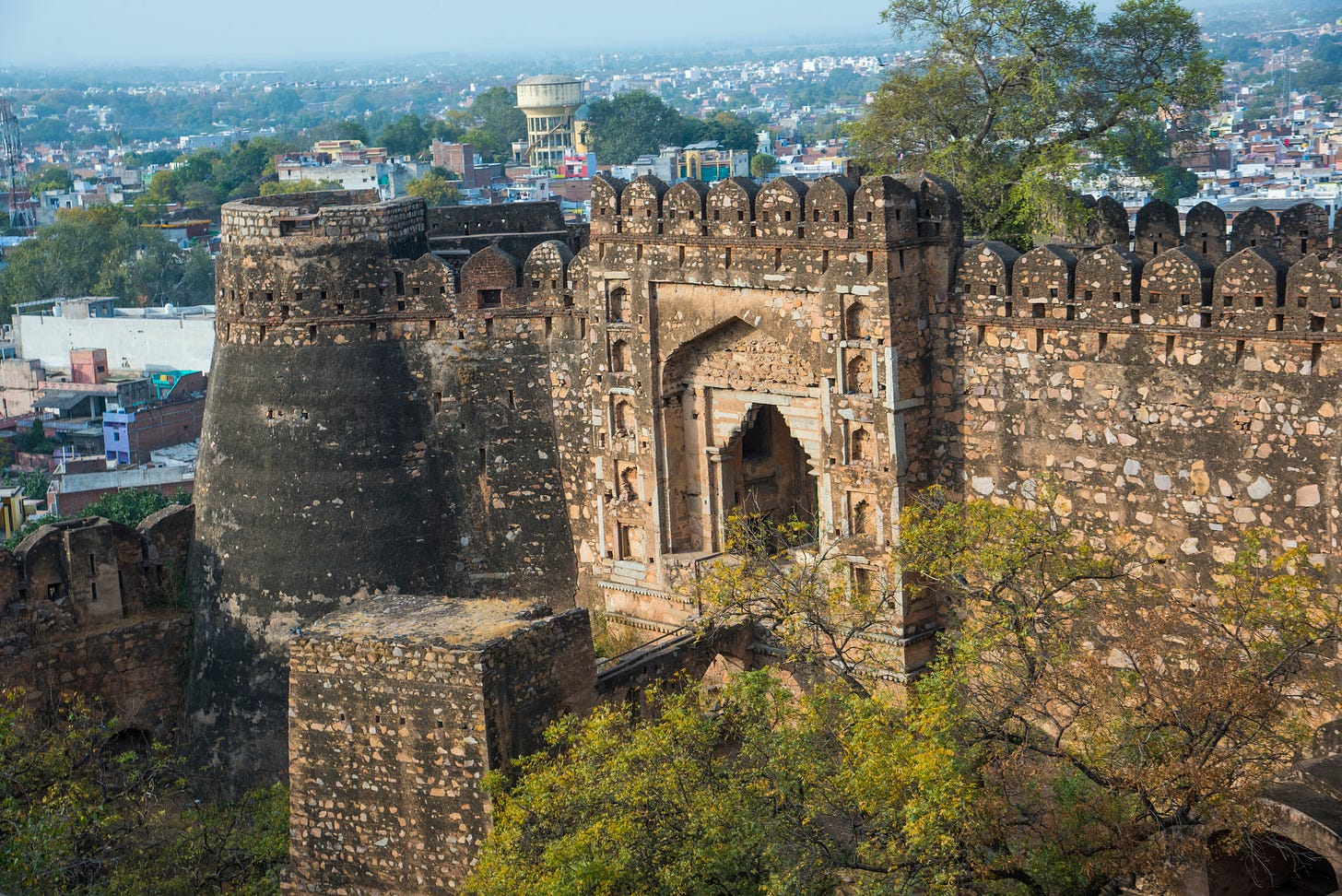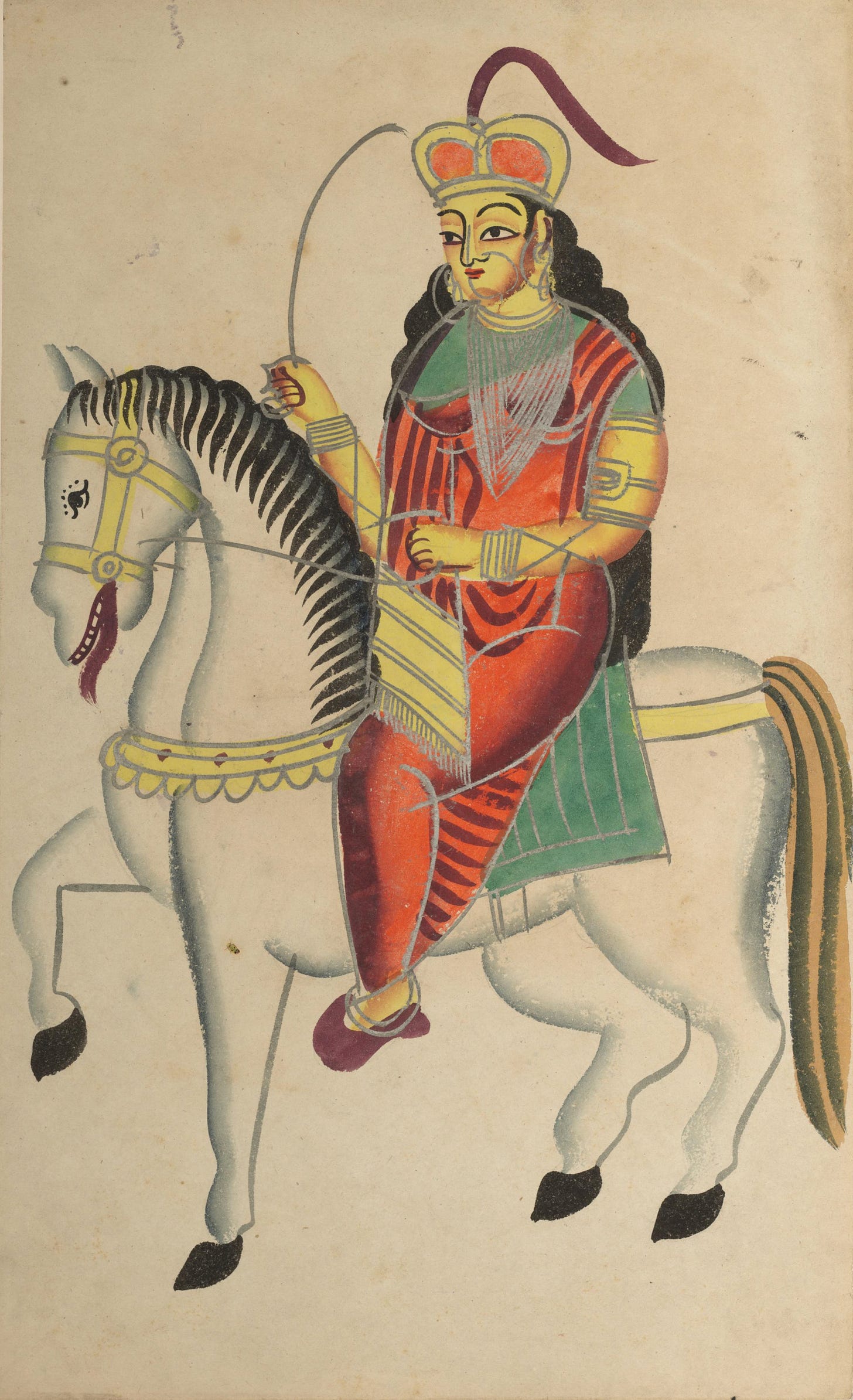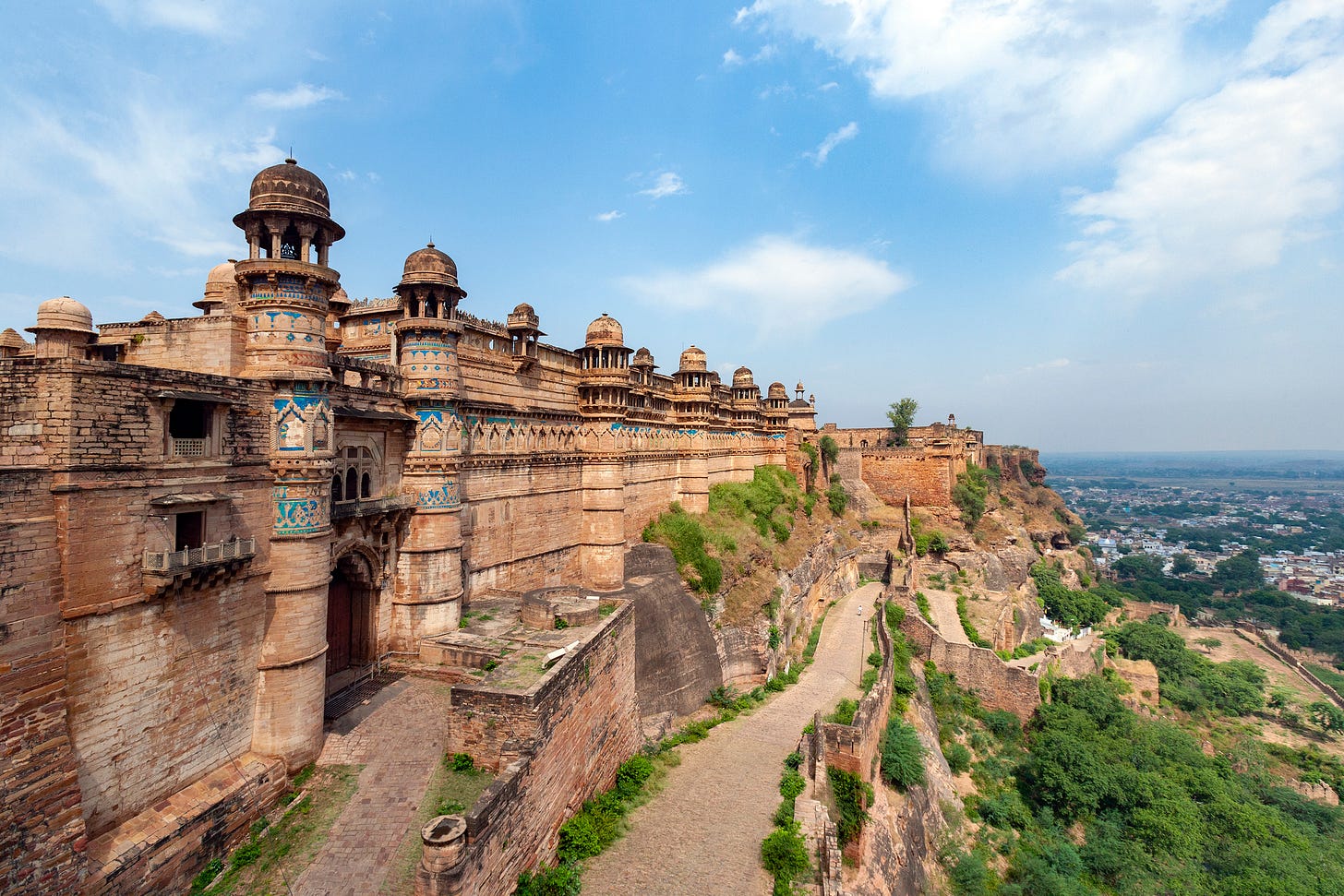🎙️ Transcript
Hey everyone,
Welcome to season four of Unruly Figures. I’m going to be doing things a little differently this season. Episodes will now top out at about 30 minutes, and I’m only going to be covering ten folks. (This doesn’t mean there will be only ten episodes, just that there will be more parts two in the future.) I’m doing this mostly to preserve my sanity as I go back to the school, and I’m excited to dig into these ten folks.
First up this season is Rani Lakshmi Bai, the queen of Jhansi who held out against British annexation in the 19th century. She went through something of a vogue in the late 2010s, with two different movies coming out about her life in 2019. She is a somewhat controversial figure in India today, both beloved as a feminist patriotic symbol and decried as a woman who stepped outside the bounds of acceptable behavior for mothers, for widows, for women.
Before we jump into this tale of colonialism and rebellion I first have to thank all of the paying subscribers on Substack whose patronage helps me make this podcast possible. This podcast wouldn’t still be going without you! If you like this show and want more of it, please become a paying subscriber over on Substack! When you’re ready to do that, head over to unrulyfigures.substack.com
All right, let’s hop into it.
Rani—or queen—Lakshmi Bai was born around 1827 in present-day Varanasi in east India. At birth, her name was Manikarnika. Her father was a Brahmon, or a priest in Hinduism, who worked as an advisor to the peshwa, or prime minister of the Maratha Empire, Baji Rao II. The Maratha Empire—sometimes called the Maratha Confederacy—was a political power in central India. It strateched as far north as Delhi and from the Indian Ocen to the Bay of Bengal laterally. Though the family was not considered aristocratic, this would have been a comfortable upbringing for Manikarnika.
When she was about four years old, her mother died. We’re not sure of what, or if she had other siblings, we just know that Manikarnika moved to the court to live with her father around this time. Baji Rao II took a liking to her and allowed her to receive an education equal to that of boys. He also allowed her to begin training in martial arts, fencing, and riding.
It’s unclear why she was singled out for this. Also her father tends to just fade away in these stories; was he a part of this education? In Hinduism at this time, women were meant to focus on family life, and as a priest in that faith I would think he’d have opinions about his daughter’s life being so antithetical to what the faith teachs.
Unfortunately, not a lot else is known about her childhood. In 1842, when she was about 15 years old, she married the “much older” Gangadhar Rao, the ruler of the nearby princely state, Jhansi.1 The Jhansi State has been a vassal of the greater Maratha Empire, and in the early nineteenth century had become a client state of Britain. The capital was the fortified city known as Jhansi Fort.

Upon her marriage, Manikarnika changed her name to Lakshmibai, a common practice in India at the time. The rest of her queenship was much less common. She ignored the norms of the purdah system and refused to be concealed from the public by veils.2 Some say that she always spoke with her male advisors, British officials, and others face to face,3 though a first hand account from a lawyer in India at the time refutes this.4 She apparently often wore a turban, an accessory more common for men, and she passed on the fighting knowledge she had gained as a child to the women in her circle.5 In the mornings, she practiced shooting and horse riding, an according to some accounts had a talent for holding the reins in her teeth while she brandished a sword in each hand.6 She also interacted with members of any social caste at a time when the caste system was much more rigid and enshrined in law.7 In fact, many of the ways she behaved would be considered bold in more conservative parts of India today.
The time of her queenship was also a history-making time. Outside of Jhansi, the British East India Company was snapping up land and resources. By the time she was queen, the Company, as it was often called in a sort of dystopian manner, had taken over much of central India.
Since some political manuevering in 1804, leadership of Jhansi had been kept within a hereditary line initially chosen by the British. Gangadhar Rao had been the brother of the previous raja, but he didn’t have any children, hence his choice of a young wife.
For several years they tried to have children, but the only boy that Lakshmi Bai gave birth to died in infancy. As it became clear in 1852 or 1853 that Gangadhar Rao’s health was declining, the couple decided to adopt one of Gangadhar’s nephews, a boy they renamed Damodar Rao when he was named the heir to Jhansi.
This was accepted practice in Hindu tradition. In the absence of biological children, rulers would adopt a child and raise them to be a successor. There was a formal ceremony to establish him as the heir, which was attended by a couple of British representatives, including a man named Major Robert Ellis a civil servant in India.

After the ceremony, the raj sent a letter to representatives of the British East India Company, writing, “I trust that in consideration of the fidelity I have evinced toward government, favor may be shown to this child and that my widow during her lifetime may be considered the Regent.”8 He had to say so because in 1848, Lord Dalhousie, India’s governor general, had declared that any princely states with leaders lacking natural born heirs (that is, not adopted) would be annexed by the British. He called the policy the Doctrine of Lapse. And once Lord Dalhousie found out that Gangadhar Rao was dead, he moved to annex Jhansi.
Now, this doctrine is obviously just an attempt to steal land more quickly and efficiently, right? Royal families in Europe had long resorted to brothers, uncles, and nephews to continue a royal house in the absence of legitimate sons. To claim that this couldn’t work in India was just greed.
This policy also went directly against the previous agreement between the British government and the previous raja of Jhansi from 1817. Lord William Bentinck had promised the previous raja (the brother of Gangadhar Rao) that “his title and the independence attached to it would be guaranteed by the British government to him, the Rajah, and his heirs and successors,” apparently including adopted ones.9
This became the basis of Lakshmi Bai’s first move: To legally fight the annexation. To contest this move by the East India Company, she sent several letters first to Lord Dalhousie then to Sir Robert Hamilton, the Governor General for India at the time. Major Ellis wrote letters in support of Lakshmi Bai, apparently arguing the legal side of this as well—Ellis often is incorrectly called her lawyer. Most of her letters were ignored, and so were Ellis’. Instead, she was offered a pension to go away, basically, but her actual lawyer John Lang noted that it was “no small matter” to ask a woman of rank to “give up such a position and become a pensioner.”10
This case made it’s way to London and dragged on for a few years. Meanwhile, Jhansi territory was being taken until Lakshmi Bai and her court were basically trapped within Jhansi Fort. She was technically forced into retirement, though she never accepted that she was not the Regent of Jhansi and that her son was not going to inherit when he came of age.
In 1857, the Sepoy Mutiny broke out. Also called the Indian Rebellion and the First Indian War of Independence, it began with discontented Indian soldiers in the East India Company Army. A lot of histories reduce their grievances down to a single issue about rifle cartridges smeared with animal fats that they couldn’t touch as part of their religious beliefs, but that’s actually a lot more to it. In addition to the racism they endured day in and day out as part of a colonial force, they were also paid significantly less than British born soldiers in the army, they didn’t want to serve abroad, and many of their cultural practices were being threatened or outright outlawed.11 The rebellion spontaneously spread across India, drawing in “landlords, merchants, and peasant farmers of both the Hindu and Muslim faiths.”12
In June, members of the Jhansi garrison mutinied, killing British officers and releasing Indian prisoners. People in the town sheltered in the weaker town fort, but it was attacked soon after. More than 60 English residents, mostly women and children, were killed by the rebels, though it’s unclear if it was rebels from Jhansi or other rebels who were traveling through to meet up with the main force of the rebellion.
Lakshmi Bai’s role in this has been debated since 1857. She had previously promised Dalhousie and Hamilton not to militarily fight them for Jhansi, and she seems to have tried really hard to keep that promise.
According to her letters reporting what happened, after the attack on the fort the mutineers attacked Jhansi Fort, demanding weapons, money, and elephants or they’d kill her. She wrote that she hoped they’d “go straight to hell for their deeds.”13 Major Ellis confirmed this, saying in a telegram that she had been “forced” to hand over these things.14 But in other accounts, mostly English ones, Lakshmi Bai actually incited the rebels. In these versions, the weapons, money, and elephants were not forcibly taken but actually payment to the rebels for the slaughter in Jhansi.
There’s no real evidence to support that interpretation though. There’s some testimony from survivors claiming that Rani Lakshmi Bai was behind it, but historians analyzing the events have pretty handily disproven those claims. They all came from folks who wouldn’t have had access to the Rani to learn about her orders or were clearly unreliable in other ways.
Despite claiming that they suspected her involvement, Major Erskine, the nearest English Commissioner to Jhansi, asked Lakshmi to take control of Jhansi while EIC troops went to handle the rebellion elsewhere. She did, gathering together a group of ministers and writing regular reports of the status of everyone in Jhansi. It wasn’t until March of 1858 that the English turned their attention back Jhansi.
This may have been because of a memo put out in February 1858 that is attributed to Rani Lakshmi Bai. After years of bad relations, she finally declared herself to be in open rebellion. In her proclamation, her grievances were listed as:
The forcible re-marriage of Hindoo widows.
The abolition of the ancient rite of suttee.
The exaltation of those who embrace the Christian faith, so also the succession to the thrones of Hindoo princes is only permitted to the legitimate sons, the adopted sons are prohibited from succession, while the Shastra gives him the same privileges as the legitimate heir: these are the stratagems by which the Europeans deprive us of our thrones and wealth.15
That final point is obviously a reference to what happened to her son, Damodar Rao. It’s probably the most powerful reason behind her rebellion. By this point, her case was clearly lost and the rebellion happening around the country was probably going to result in severe retributions if it wasn’t successful; she might have thought neutrality or compliance were no longer options.
Her first two points were something the British had been fighting for a long time. Sati was a longstanding Hindu practice of a widow immolating herself on her husband’s funeral pyre. It was already falling out of fashion by the nineteenth century, but Lord William Bentinck, governor general of India, completely banned it it in 1829. The punishments for enabling sati were harsh, and people were pretty unhappy about this social intervention by the British.
Then Lakshmi Bai’s first point, about forcible re-marriage seems to be a reaction to an 1856 act that allowed for the remarriage of all widows; until then, upper-caste widows could not remarry. The law allowed for any widow to remarry if she wanted to, and was especially targeted toward young widows who had lost their husbands before they were legal adults.
It’s interesting to me that she has phrased it as “forcible re-marriage.” That could just be a translation issue, but just in case I looked into reactions to this 1856 law just to see if other people were interpreting the law that way. It was a controversial law because it was seen as the British overstepping and trying to Christianize Indian culture. But the law doesn’t seem to be forcing anyone to remarry. Celibacy was still an option.
It makes me wonder if she was being pressured to remarry. Here’s the thing: the 1856 law did take away the widow’s right to the deceased husband’s estate.16 Anything she inherited from the marriage, or would be due to inherit through her husband, was forfeit if and when she remarried. For Lakshmi Bai, that would have included Jhansi. Since EIC officers were clearly already willing to disregard prior law and manipulate the truth in an effort to win Jhansi from her, I wonder if she was being told that the law actually required her to remarry, even though it didn’t. That’s the only reason I can think of that she would call it “forcible remarriage,” and why she would wait two years to take issue with the law. Maybe she was being pressured and this was the last straw that kicked off her rebellion.
Again, worth noting though that the memo is attributed to her but not provably written by her. And even if it is, “forcible re-marriage” could be a translation issue.
Nevertheless, in late March 1858, troops led by General Hugh Rose laid siege to Jhansi. The fort held out for two weeks, but the British eventually broke through.17 Lakshmi Bai managed to escape under cover of darkness, her son strapped to her back. Some stories have her leaping off the fortress wall directly on to her horse, which seems like a dangerous move with a child strapped to you. Also seems like it would really injure the horse. But this daring move does make it into movies about her.
Though Lakshmi Bai escaped the fort, many people did not. Estimates of the death toll range from 1,000 to 5,000. Though British troops were instructed to spare women, I’m betting that probably did not happen, or at least that the women weren’t spared violence, even if they were allowed to live. Writing after the event, Dr. Thomas Lowe celebrated, “Such was the retribution meted out to this Jezebel Ranee and her people for the heinous crimes done by them in Jhansi.”18 Remember, this was supposedly payback for the death of sixty British civilians committed by EIC soldiers who were not even still in Jhansi.
Having escaped, Lakshmi Bai met up with other rebel leaders at nearby Kalpi, but they failed to hold it. She then led an attack on the fortress at Gwalior, which was successful. She began training an army there, but in June 1858 the British attacked. She led a countercharge against them, “clad in the attire of a man and mounted on horseback.”19 It’s easy to imagine that her ability to hold reins in her teeth and swing two swords would have come in very handy here.

But the battlefield outside Gwalior was where Lakshmi Bai was killed. According to one report, she was shot in the back by a soldier with the Eighth Hussars. “When she turned to fire back, he ran her through with his sword and killed her.”20
With her death, the rebellion more or less fell apart. Certainly Gwalior was the last major battle of the rebellion. Her enemy, General Rose, would later acknowledge her courage by writing, “the Indian Mutiny had produced but one man, and that man was a woman.”21
Though the rebels lost, their fight led to the dissolution of the East India Company over concerns about their incredibly violent rule. India was not freed though—the country just came under control of the crown and the people living there became British subjects. One of Queen Victoria’s first acts as Empress of India was to reverse Lord Dalhousie’s policy of annexing principalities that didn’t have biological heirs.22
Lakshmi Bai’s son, Damodar Rao, managed to escape. He later wrote a memoir, in which he describes “years of great suffering as he and his protectors struggled through a landscape of jungleand ravines.”23 He eventually surrendered and was granted a very small pension. He lived out his days in poverty and neither he nor any of his descendants have ever been granted any kind of recognition as members of the last ruling Raj of Jhansi’s family.
Lakshmi Bai’s name lives on in many ways. When Subhash Chandra Bose revamped the Indian National Army, he “raised the only regiment of female soldiers on any side in the Second World War and named it the Rani of Jhansi regiment.”24 Unfortunately Bose’s legacy, and to some extent the legacy of the INA, is tainted by his collaboration with Nazi Germany.
In India, Lakshmi Bai’s story is incredibly well-known but her legacy is a difficult one. As I mentioned at the top, her defiance of gender roles is seen as both inspiring and cautionary. She is frequently framed as a nationalist hero, but also as a Jezebel and called a whore. That she was reputedly beautiful and charming works both for and against her, and her relationship with the British Major Ellis has repeatedly come into question. In a lot of modern treatments of her life, their relationship is often romantic, sometimes sexual—sometimes that blooms after her husband’s death but sometimes she’s also an adultress, sneaking out to meet up with Ellis while her husband the Raj is on his deathbed. It’s rough. And the British propaganda against her is strengthened by the fact that Indian treatments of the rebellion were heavily censored until after Indian independence. There are few contemporary accounts from the Indian perspective.
And of course, Harleen Singh writes in her treatment of Lakshmi Bai in Women Warriors and National Heroes, “The fact that she died provided the perfect Deus ex machina for all narratives to follow; neither British nor Indian representations have to deal with the real problem of a woman in power.”25
That is the story of Rani Lakshmi Bai! I hope you enjoyed this episode. You can let me know your thoughts on Substack and Instagram, where my username is unrulyfigures. If you have a moment, please give this show a five-star review on Spotify or Apple Podcasts–it really does help other folks discover the podcast.
This podcast is researched, written, and produced by me, Valorie Clark. If you are into supporting independent research, please share this with at least one person you know. Heck, start a group chat! Tell them they can subscribe wherever they get their podcasts, but for ad-free episodes and behind-the-scenes content, come over to unrulyfigures.substack.com.
If you’d like to get in touch, send me an email at hello@unrulyfigurespodcast.com or leave a comment on Substack.
Until next time, stay unruly.
If you liked this story, you might like the story of Mekatilili wa Menza, a key freedom fighter against British encroachment in Kenya.
📚 Bibliography
BBC Bitesize. “Women’s Rights and Inclusion - Practices in Hinduism - GCSE Religious Studies Revision - AQA.” Accessed September 5, 2024. https://www.bbc.co.uk/bitesize/guides/zvrsv9q/revision/10.
Biswas, Soutik. “Sati: How the Fight to Ban Burning of Widows in India Was Won.” BBC, April 23, 2023. https://www.bbc.com/news/world-asia-india-65311042.
Broun-Ramsay, James Andrew. The Hindu Widows Remarriage Act, Act XV § (1856).
Cartwright, Mark. “Sepoy Mutiny.” In World History Encyclopedia. World History Publishing, October 18, 2022. https://www.worldhistory.org/Sepoy_Mutiny/.
Copsey, Allen. “Lakshmibai, Rani of Jhansi - Annexation.” Accessed September 9, 2024. https://www.copsey-family.org/~allenc/lakshmibai/retire.html.
———. “Lakshmibai, Rani of Jhansi - Documents.” Accessed September 9, 2024. https://www.copsey-family.org/~allenc/lakshmibai/documents.html.
Corichi, Neha Sahgal, Jonathan Evans, Ariana Monique Salazar, Kelsey Jo Starr and Manolo. “4. Attitudes about Caste.” Pew Research Center (blog), June 29, 2021. https://www.pewresearch.org/religion/2021/06/29/attitudes-about-caste/.
Gupta, Alisha Haridasani. “Overlooked No More: Rani of Jhansi, India’s Warrior Queen Who Fought the British - The New York Times.” The New York Times, August 14, 2019, sec. Obituaries. https://www.nytimes.com/2019/08/14/obituaries/laxmibai-rani-of-jhansi-overlooked.html.
“Lakshmibai, Rani of Jhansi - Mutiny.” Accessed September 9, 2024. https://www.copsey-family.org/~allenc/lakshmibai/mutiny.html.
Lang, John. Wanderings in India: And Other Sketches of Life in Hindostan. Routledge, Warne, & Routledge, 1861.
Pagano, Alessandra. “Lakshmi Bai, India’s Warrior Queen Who Fought the British.” National Geographic, October 6, 2020. https://www.nationalgeographic.com/history/history-magazine/article/india-warrior-queen-lakshmi-bai-fought-british-rule.
Sarkar, Sumit, and Tanika Sarkar. Women and Social Reform in Modern India: A Reader. Indiana University Press, 2008.
Singh, Harleen. “India’s Rebel Queen: Rani Lakshmi Bai and the 1857 Uprising.” In Women Warriors and National Heroes, edited by Boyd Cothran, Joan Judge, and Adrian Shubert, 23–38. Bloomsbury Academic, 2020. http://www.bloomsburycollections.com/collections/monograph-detail.
———. “The Rani Rides Again: After Padmavati, Manikarnika’s Rani of Jhansi Gets Caught in the Crossfire.” The Wire, sec. Film. Accessed September 9, 2024. https://thewire.in/film/rani-rides-padmavati-manikarnikas-rani-jhansi-gets-caught-crossfire.
“The Mutiny of the Heroine Rani Lakshmi Bai of Jhansi | Cleveland Museum of Art.” Accessed September 9, 2024. https://www.clevelandart.org/art/2003.146.
The Wire - India. “The Warrior Queen: Lakshmibai, the Rani of Jhansi,” March 8, 2024. https://review.gale.com/2024/03/08/the-warrior-queen-lakshmibai-the-rani-of-jhansi/.
Alessandra Pagano, “Lakshmi Bai, India’s Warrior Queen Who Fought the British,” National Geographic, October 6, 2020, https://www.nationalgeographic.com/history/history-magazine/article/india-warrior-queen-lakshmi-bai-fought-british-rule.
Alisha Haridasani Gupta, “Overlooked No More: Rani of Jhansi, India’s Warrior Queen Who Fought the British - The New York Times,” The New York Times, August 14, 2019, sec. Obituaries, https://www.nytimes.com/2019/08/14/obituaries/laxmibai-rani-of-jhansi-overlooked.html.
Gupta, “Overlooked No More”
John Lang, Wanderings in India: And Other Sketches of Life in Hindostan (Routledge, Warne, & Routledge, 1861).
Gupta, “Overlooked No More”
Allen Copsey, “Lakshmibai, Rani of Jhansi - Annexation,” accessed September 9, 2024, https://www.copsey-family.org/~allenc/lakshmibai/retire.html.
Gupta, “Overlooked No More”
Gupta, “Overlooked No More”
Lang, 85
Lang, 86
Mark Cartwright, “Sepoy Mutiny,” in World History Encyclopedia (World History Publishing, October 18, 2022), https://www.worldhistory.org/Sepoy_Mutiny/.
Cartwright, “Sepoy Mutiny”
Pagano, “Lakshmi Bai”
Allen Copsey, “Lakshmibai, Rani of Jhansi - Documents,” accessed September 9, 2024, https://www.copsey-family.org/~allenc/lakshmibai/documents.html.
Copsey, “Lakshmibai, Rani of Jhansi - Documents”
Sumit Sarkar and Tanika Sarkar, Women and Social Reform in Modern India: A Reader (Indiana University Press, 2008).
Pagano, “Lakshmi Bai”
Harleen Singh, “India’s Rebel Queen: Rani Lakshmi Bai and the 1857 Uprising,” in Women Warriors and National Heroes, ed. Boyd Cothran, Joan Judge, and Adrian Shubert (Bloomsbury Academic, 2020), 23–38, http://www.bloomsburycollections.com/collections/monograph-detail.
Gupta, “Overlooked No More”
Pagano, “Lakshmi Bai”
Pagano, “Lakshmi Bai”
Gupta, “Overlooked No More”
Pagano, “Lakshmi Bai
Singh, 26
Singh, 30
















Share this post